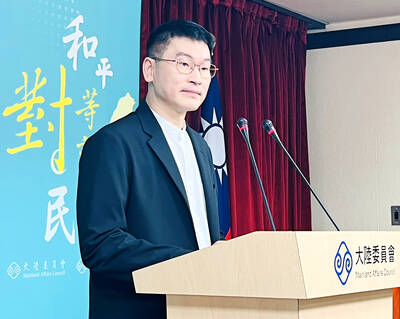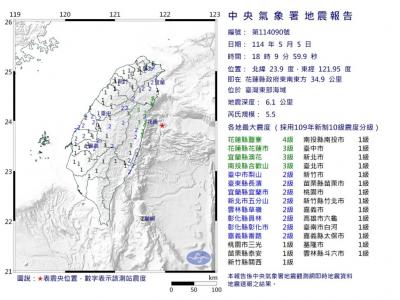Long before Portuguese sailors put "Formosa" on the world map, and long before Chinese people crossed the dark current to set up home here, this land was inhabited by Austronesian Aborigines for thousands of years. Multigenetic analysis reveals that Austronesian tribes arrived as early as 14,000 years ago.
According to Marie Lin (
"Even before Taiwan became an island, forefathers of Taiwan's indigenous peoples arrived in Taiwan in the late pleistocene ice age," Lin said after a conference at Mackay Memorial Hospital yesterday.
Lin had previously delivered the paper in June at an international conference on Human Migrations in Continental East Asia and Taiwan at the University of Geneva.
Lin's theory of the origin of Taiwanese Aboriginals sheds light on the role the island plays as a transition station for archaic hominid populations. In genetic and archaeological studies, the most recognized model on modern human origins suggests two routes out of Africa in prehistory. One is the northern route toward Europe and North Asia. The other is the southern coastal route from Africa toward East Asia and Oceania. It is on the southern route that Taiwan served as a midway hub for the earliest human migration.
"Genetically speaking, Taiwan is one of the most probable sources of the Austronesian family," said Toomas Kivisild, research fellow at the Department of Evolutionary Biology at the University of Tartu in Estonia, who found his study on the database in Lin's lab. Based on comparisons of genetic sequencing, Kivisild inferred that Polynesian migration is likely to have originated in Taiwan, followed by a later maturation and interaction phase in the islands that are now eastern Indonesia and Melanesia.
Kivisild's model demonstrated that while there is a genetic link between the indigenous Taiwanese and the ancestors of present-day Polynesian populations, there is no Austronesian lineage that could be traced back to a Neolithic migration from China.
The genetic evidence, however, is at odds with anthropological data that support the theory that there were contacts with China even in the Neolithic age.
In Taiwan, the Neolithic stage is represented by the oldest ceramic culture of the island, the Tapenkeng culture site in Pali (
"Based on comparison of pottery traits, it could be said that the region of the southeast coast of China, including Taiwan, is the Austronesian homeland," Tsang said.
"In the quest for origin, different disciplines have different compasses and road maps. At the edge of the knowable, every evidence has its own message," Tsang said to explain the discrepancy between the genetic and anthropological findings.
"Hopefully, as more clues come to light, one day the scientists, anthropologists and linguists will tell the same story of human beings, a story of where we all come from."

An essay competition jointly organized by a local writing society and a publisher affiliated with the Chinese Communist Party (CCP) might have contravened the Act Governing Relations Between the People of the Taiwan Area and the Mainland Area (臺灣地區與大陸地區人民關係條例), the Mainland Affairs Council (MAC) said on Thursday. “In this case, the partner organization is clearly an agency under the CCP’s Fujian Provincial Committee,” MAC Deputy Minister and spokesperson Liang Wen-chieh (梁文傑) said at a news briefing in Taipei. “It also involves bringing Taiwanese students to China with all-expenses-paid arrangements to attend award ceremonies and camps,” Liang said. Those two “characteristics” are typically sufficient

A magnitude 5.9 earthquake that struck about 33km off the coast of Hualien City was the "main shock" in a series of quakes in the area, with aftershocks expected over the next three days, the Central Weather Administration (CWA) said yesterday. Prior to the magnitude 5.9 quake shaking most of Taiwan at 6:53pm yesterday, six other earthquakes stronger than a magnitude of 4, starting with a magnitude 5.5 quake at 6:09pm, occurred in the area. CWA Seismological Center Director Wu Chien-fu (吳健富) confirmed that the quakes were all part of the same series and that the magnitude 5.5 temblor was

The brilliant blue waters, thick foliage and bucolic atmosphere on this seemingly idyllic archipelago deep in the Pacific Ocean belie the key role it now plays in a titanic geopolitical struggle. Palau is again on the front line as China, and the US and its allies prepare their forces in an intensifying contest for control over the Asia-Pacific region. The democratic nation of just 17,000 people hosts US-controlled airstrips and soon-to-be-completed radar installations that the US military describes as “critical” to monitoring vast swathes of water and airspace. It is also a key piece of the second island chain, a string of

The Central Weather Administration has issued a heat alert for southeastern Taiwan, warning of temperatures as high as 36°C today, while alerting some coastal areas of strong winds later in the day. Kaohsiung’s Neimen District (內門) and Pingtung County’s Neipu Township (內埔) are under an orange heat alert, which warns of temperatures as high as 36°C for three consecutive days, the CWA said, citing southwest winds. The heat would also extend to Tainan’s Nansi (楠西) and Yujing (玉井) districts, as well as Pingtung’s Gaoshu (高樹), Yanpu (鹽埔) and Majia (瑪家) townships, it said, forecasting highs of up to 36°C in those areas